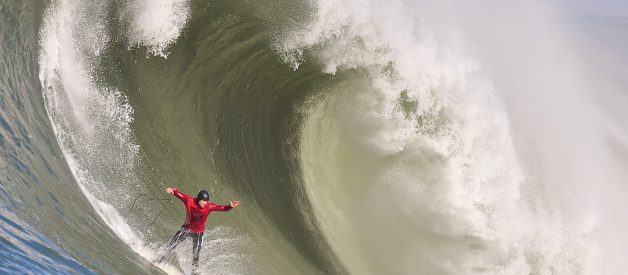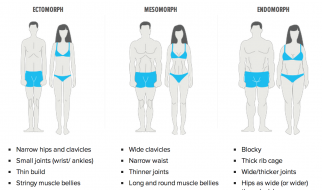I pick up the board, feeling the sticky wax under my fingertips. I carry it, under my arm, over the soft sand, and wade slowly into the cool water, sometimes feeling a smooth pebble under my toes. I dive over the rumbling, white foam, landing my belly on the board, and paddle efficiently past where the waves break.
As I paddle up the steep face of a green wave, I look to my right and see an athletic young woman dive the pointed tip of her tiny board through the high, glassy wall, slipping horizontally into the depths of the ocean.
I sit on my board, rising and falling slowly, surveying the horizon, waiting, relaxing. As a big set of waves rolls in, I watch a group of two or three surfers turn their boards towards where it will peak, and begin paddling out to meet it. One of them paddles in a small circle, timing his rotation so that he is paddling in the direction that the wave is moving as it rises underneath him. As I slide up over the soft shoulder of the wave, I see the splashing of arms and legs as he thrusts himself down its face, dropping-in while standing up.
When it comes to surfing, I?m just a beginner. I?ve been surfing now and then for about five years, including a period of about three months when I surfed twice per day in Costa Rica. It took me almost all of that time to get to the point where I could stand up and surf green waves, of which I have included a video at the end of this article.
I just returned from a trip to one of my favorite surfing beaches in Costa Rica, and I feel inspired write about surfing. In this article, I?m not going to tell you about how to position yourself to catch the wave, how to paddle for it, and how to pop-up and ride the wave down the line. Those are relatively advanced skills, and they have been written about extensively.
Instead of getting frustrated trying to do those things and failing, I?m going to guide you to learn the core skills you actually need in order to surf well. Then you can focus on learning those skills directly and quickly, rather than learning them indirectly and slowly.
Ninety-five percent of learning to surf comes from getting into the ocean regularly. Even though I made that statistic up, it should convey that regular and intense practice is both necessary and sufficient. Many skills can be practiced almost anywhere. For example, you can practice playing the guitar as long as you have your guitar with you. For surfing, you need the right kind of waves, and that usually means entering an ocean at just the right place at just the right time.
This means having a way to carry your board on your car, ATV, or scooter, and it?s probably a big board if you?re beginner. Unless you live near a wave pool like Nland in Austin, Texas, you will need to monitor swells, tides, and winds. If you live near a cold ocean, you?ll need a wetsuit, and a way to transport it, rinse it, and dry it.
All of this means that it?s very unlikely that you?re going to take a surfing lesson while on vacation and then suddenly find yourself shredding deep inside gnarly overhead tubes, whatever that means. Learning to surf is usually a very slow process that involves many long, healing drives to the beach, and thousands of hours of contemplative sitting-around doing nothing much.
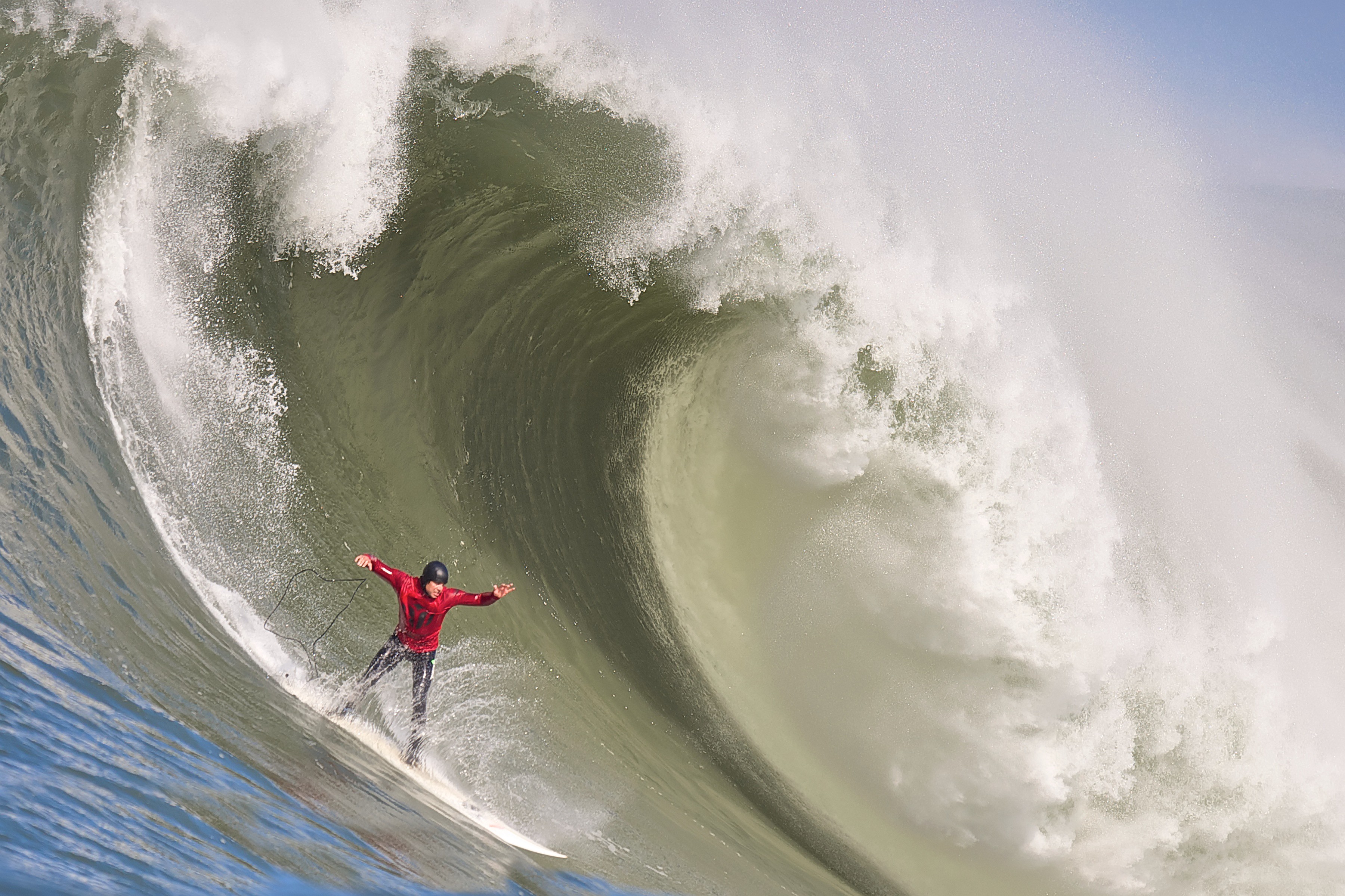 Mavericks Surf Content 2010 ? Wikimedia
Mavericks Surf Content 2010 ? Wikimedia
Learn safety first
The movie Chasing Mavericks is based on the true story of how Frosty Hesson trained 16-year-old Jay Moriarity to ride the 25-foot-tall waves of Mavericks at Half-Moon Bay in Northern California. Before allowing Jay to join him and his buddies on those behemoths, Frosty required Jay to paddle 36 miles across Monterey Bay, tread water for forty minutes, and hold his breath for four minutes. I used to think that this was overkill, but the more I have come close to death while surfing normal waves, the more sensible Frosty?s training seems.
While teaching my wife, Cindy, to surf recently, the first thing I taught her was board safety:
- Always keep the board leashed to your ankle, and attach the leash before you enter the water.
- Make sure that the leash is snug around your ankle, so that it can?t slip over your foot when a powerful wave is pulling on it.
- Learn how to remove the leash quickly from your ankle using only touch. You might need to do this underwater, in an emergency, when the leash is snagged around a rock on the bottom of the ocean.
- Unless all of your weight is on the board, never allow the board to be between you and the wave. You will not be able to stop a wave from smashing the board into you.
- When paddling over the top of a wave, brace your forearms against the board to prevent the wave from smashing the board into your face.
- When you fall off the board, try to push it away from you in the direction of the movement of the wave. It?s usually best to fall back over or into the wave while letting the board continue with the wave. Otherwise, it?s easy for the board to get behind and/or above you inside a wave so that it then gets smashed into you.
- Before losing control of your board, make sure that it will not hit anyone nearer the shore.
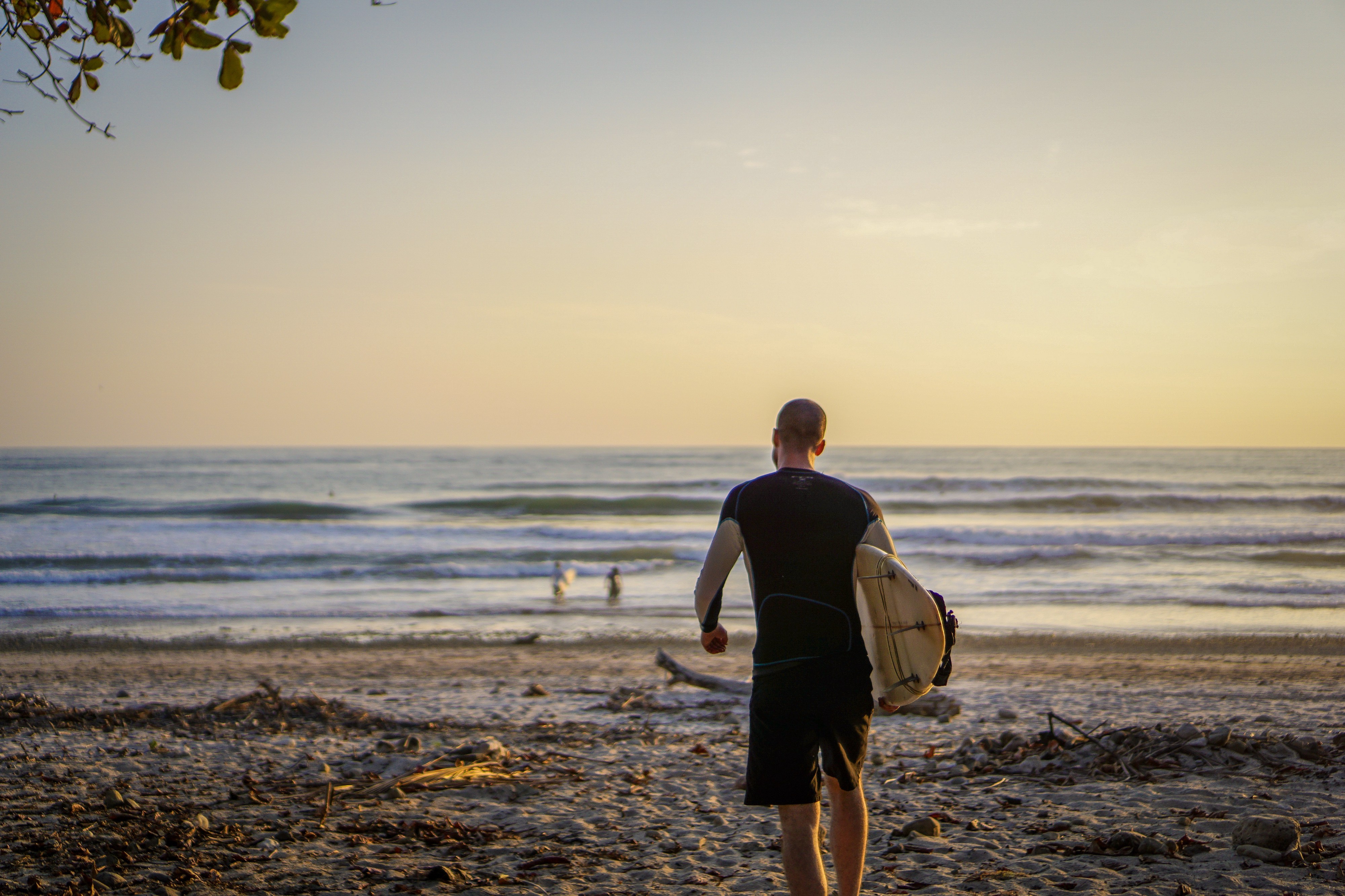 This is me heading out to surf at Banana Beach in Costa Rica.
This is me heading out to surf at Banana Beach in Costa Rica.
I was once hit in the head by board in Costa Rica, and spent some time with paramedics to determine whether I had a concussion. Being overly cautious, they wanted to take me by helicopter to the capital (San Jose) to get my head scanned. I waited until I was back in San Jose anyway to get an x-ray, to make sure I didn?t have a concussion before I got into a pressurized plane cabin. It?s relatively easy, and extremely important, to avoid letting the board get between your head and the wave. A common way to die when surfing is to be knocked unconscious by the board, or by a rock, and then drown while being pinned down by the waves.
Once, I was surfing some relatively big waves on a reef break a long paddle off the coast near Biarritz in the South of France. Cindy strapped on a board and paddled out with us to watch from the side. We stationed her in an area where the ocean floor was deeper, and therefore where the waves were not breaking.
After a while, a freak set of enormous waves arrived which were so large that they broke all the way across, including the place where Cindy was spectating from. Cindy has tiny ankles, and the leash on her board was designed to fit around the calf of a man. It was possible to attach the strap of the leash snugly to her ankle, but it required some knowledge and skill. Not realizing the risks, I had let Cindy attach the leash herself. The strap was loose enough that when a big wave knocked her off the board and tugged on the leash, it came free from her ankle. This left her stranded half-a-mile out in the ocean without a board, and with a relentless set of enormous waves crashing onto her. Luckily, our local friend happened to spot Cindy struggling in the waves, and he saved her from drowning. While he stayed with her, I paddled after his spare board and stopped it from getting smashed into some rocks. It?s probably also lucky that Cindy was wearing a neoprene wetsuit, because that would have given her some extra buoyancy.
I?ve written above about basic board safety above. Later, you?ll be paddling out to the green waves, and catching them. Before doing that, you should know surfing etiquette. You can google that later.
Learn to paddle
I?ve been taught by several different surfing instructors. First, while lying on my board, on the beach, they showed me how to paddle to catch a wave and then to stand up on the wave, which is called popping-up. The in-ocean practice then consisted mostly of me paddling to catch little waves, with them pushing my board, followed by attempts at standing up.
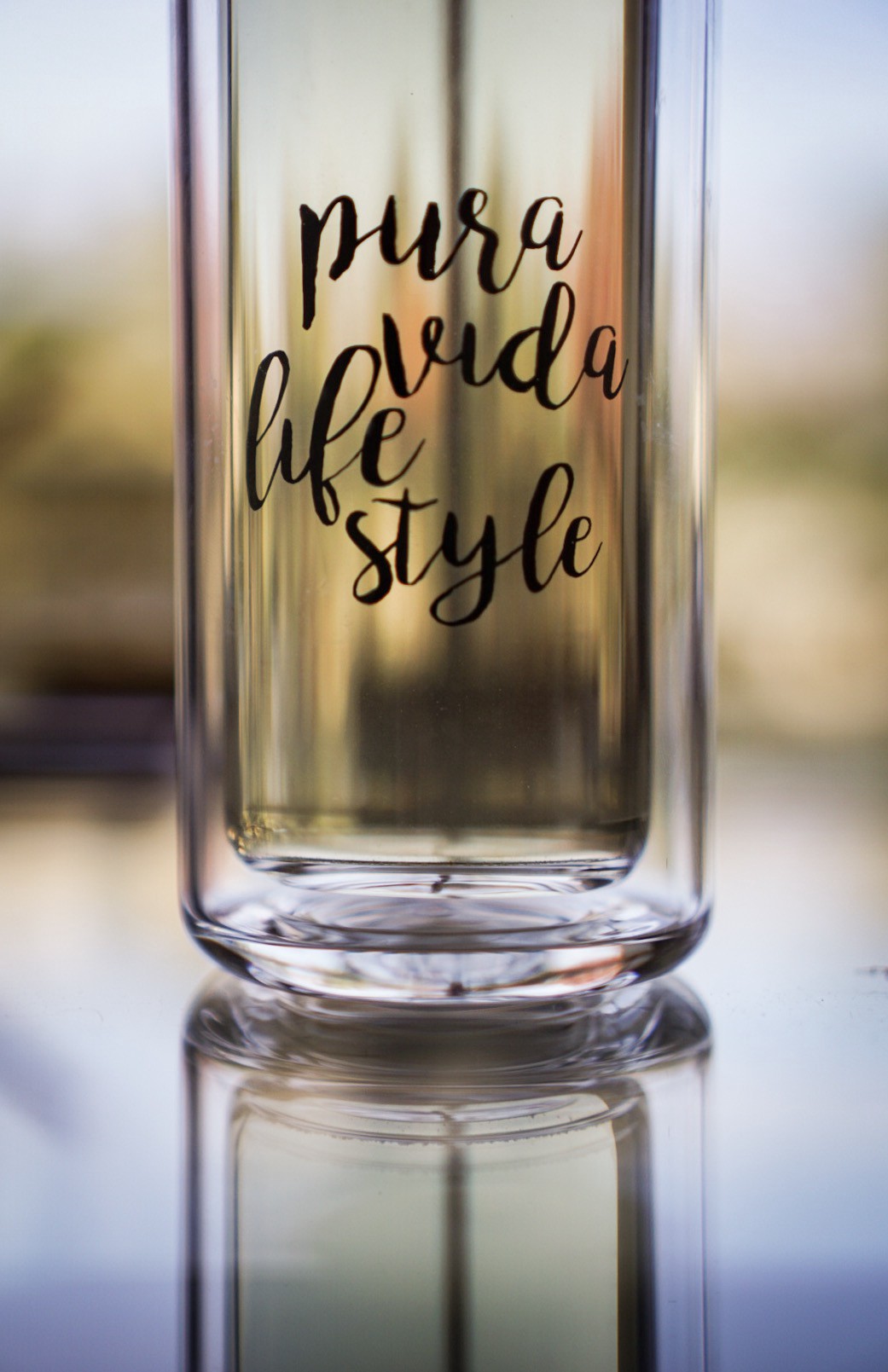 This beautiful glass vacuum flask for tea is made by Luni of Costa Rica. We brought this home from our most recent trip.
This beautiful glass vacuum flask for tea is made by Luni of Costa Rica. We brought this home from our most recent trip.
Unless you go to a multi-day, or multi-week surf camp, an instructor only has an hour or two with you. They want you to have a fun experience with them, so they?re focused on helping you to catch waves and stand up. ?I stood up!? is the success cry from a typical surfing student. However, even though being a surfing instructor usually means that you?re reasonably good at surfing, and probably also like to smoke weed, it says very little about your ability to teach.
In my recent surfing lessons with Cindy, I helped her to learn how to paddle the board in the water. While the board she was using was slightly smaller than I?m used to?compared to my body-size, it?s a large shortboard, and I?m used to what?s called a fun board?for her, it was more like a longboard. Because it was so large and buoyant for her size, I expected her to easily be able to balance on the board. I was amazed to watch how difficult it was for her to keep her bodyweight in the center of the board, and then paddle it smoothly forward while not sliding off to one side or the other. I realized that even though I am a relative beginner, I have come a very long way in my ability to balance on a board and paddle it effortlessly through the water.
Effective board paddling is a core skill, which is both hard to master and critical to achieving many goals in surfing, including:
- Paddling out fast to get beyond where the smaller waves break to what?s called the line-up, which is where the larger waves begin to break.
- Paddling to maintain general position, both parallel to the shore and perpendicular to the shore. The tides and currents continually shift where you are in the ocean relative to the shore, as well causing the place where the waves are breaking to keep moving.
- Paddling to position yourself to optimally catch any given wave where it?s peaking, but just before it breaks. The objective is then to stand up, turn the board, and surf along the smooth face of the wave, while it breaks behind you.
- Paddling to accelerate your board close to the speed of a wave rising under your board, so that you can slide your board down the front of the wave, thereby catching it.
Paddling is necessary for all of these reasons, which means that we paddle a lot while surfing. With practice, we get better at paddling a surfboard, which improves our surfing in general because we improve in all of the above areas. Because of this, if we take our board into the ocean and fail to get through to the line-up, or fail to catch any waves, we can at least know that we?ve practiced paddling, and therefore that we must be getting better. This is why I had Cindy just practice getting onto the board and paddling it during our lessons.
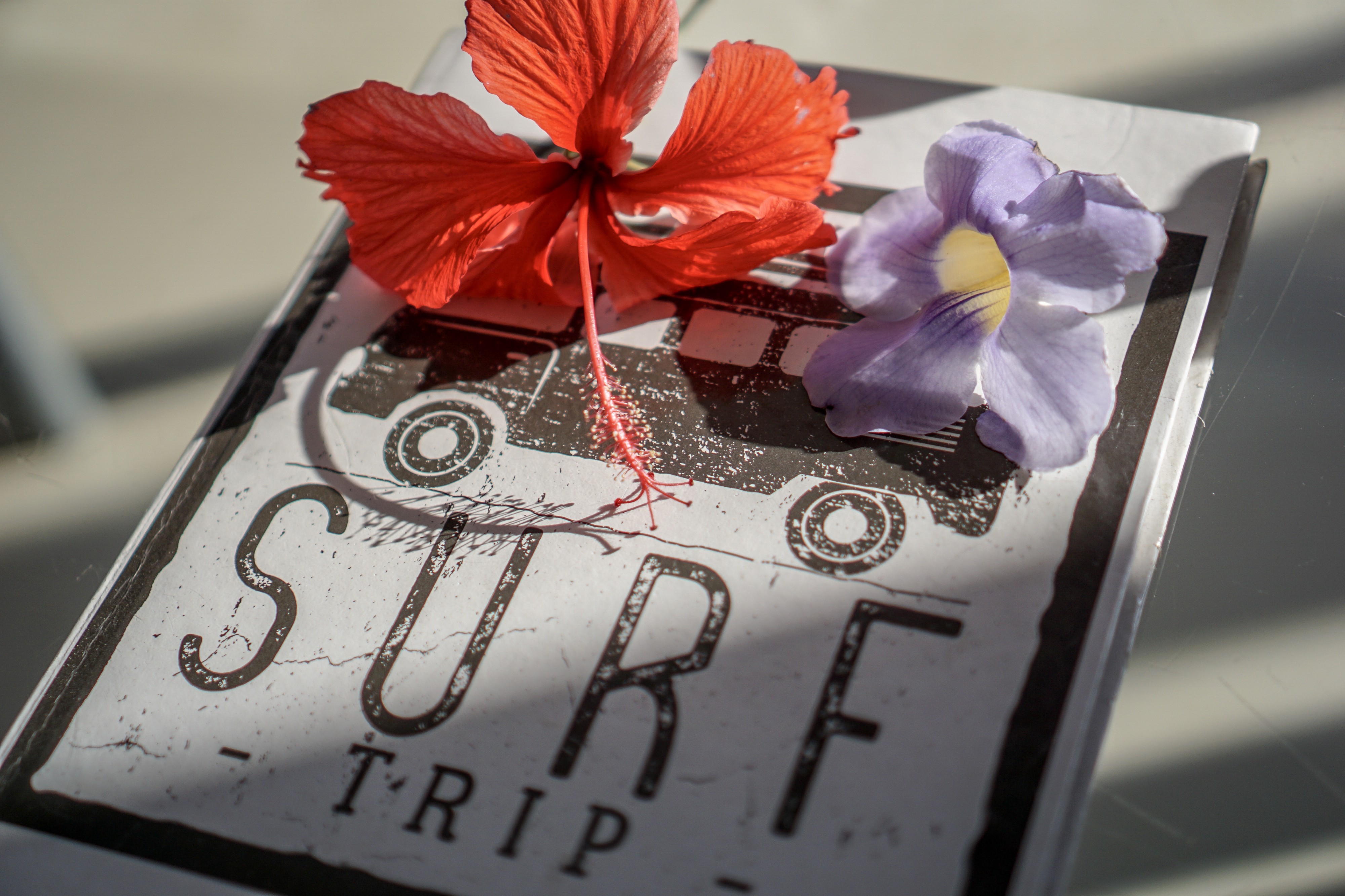 Hibiscus and morning glory are abundant in Costa Rica. This is the guest book at the Airbnb that we stayed at recently.
Hibiscus and morning glory are abundant in Costa Rica. This is the guest book at the Airbnb that we stayed at recently.
Learn to get out through the waves
On my last surfing trip, the first time I got into the water I struggled hard but was not able to get myself and the board out past the breaking waves to the lineup. I also have relatively low stamina, since I?ve been recovering from surgery. After exhausting myself trying to get past the waves, I came back to relax on the beach, knowing that my efforts had not been wasted. The next day, I easily made it to the outside, to wait with the other surfers for waves.
Getting to the outside, to the line-up, is often one of the hardest things you have to do in surfing. Where there are good waves to surf, those waves break and then race in to the shore. Unless you can get to the outside, then you can?t really surf. To get out to where the waves break, you have to get yourself and the board through the powerful, tumbling mounds of whitewater, and then through one or more zones where green waves stack up, curl over, and crash down onto you.
To do this, you have to develop skill in:
- Jumping the board over whitewater waves where you can still stand up.
- Paddling over smaller, broken whitewater waves, or over unbroken green waves.
- Duck-diving a smaller board under or through larger broken or breaking waves. Duck-diving means pushing the nose of the board down and through the wave, and diving through and under with it.
- Turtle-rolling a larger board under or through larger broken or breaking waves. Turtle-rolling means to paddle towards the wave and then grip the board and roll over, so that the board is upside-down with you attached in a ball position underneath it, as the wave passes.
- Most importantly, once a wave has passed, quickly getting back onto the board and making progress by paddling rapidly towards the outside.
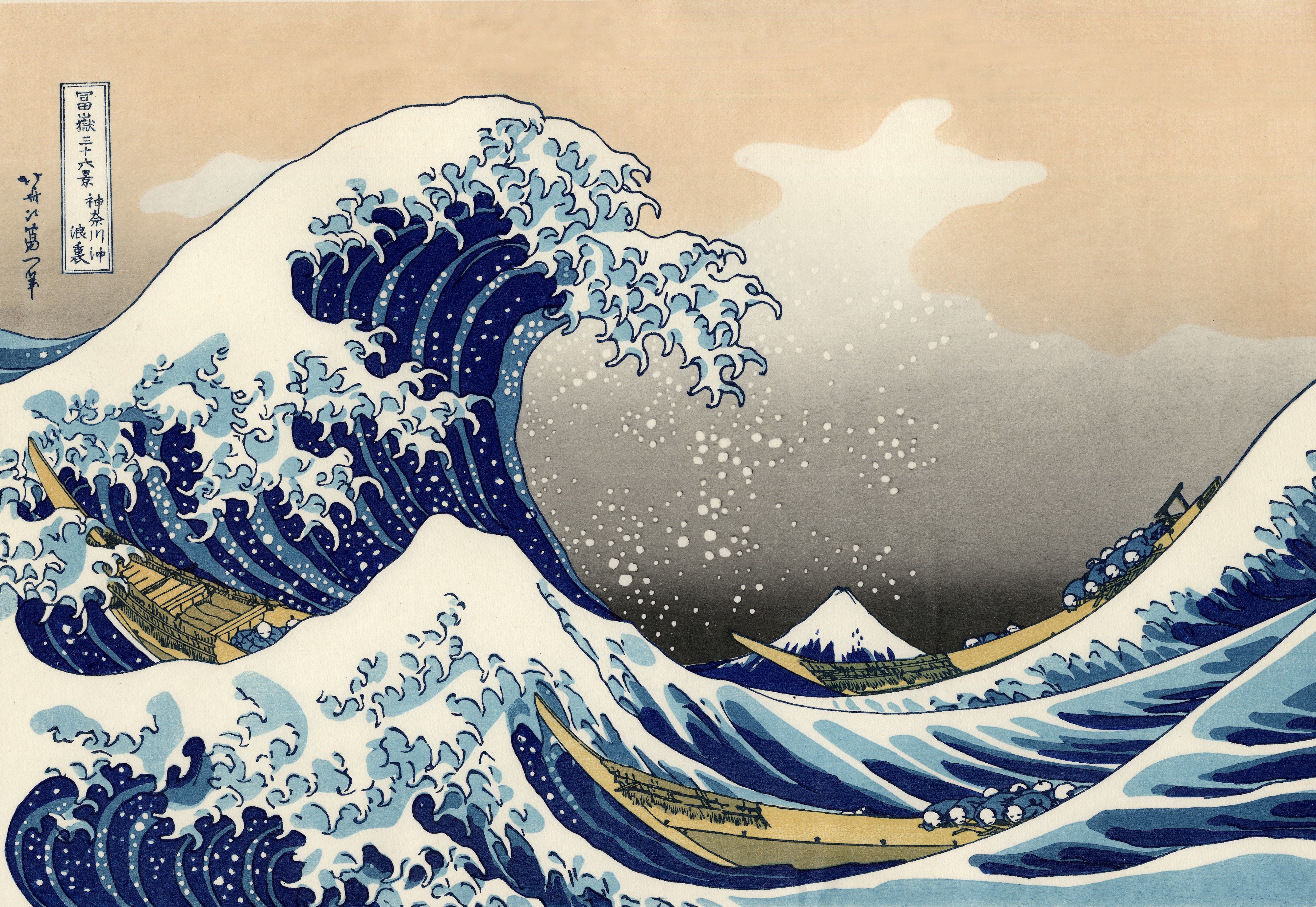 The Great Wave off Kanagawa ? Wikimedia
The Great Wave off Kanagawa ? Wikimedia
As with most things in life, even if other people seem to be struggling, there?s usually an easier way. Sometimes the water carried up onto the shore in the waves returns into the ocean through a single channel, known as a rip current. As I wrote about in For Our Anniversary, We Almost Died Together, rip currents can kill you, but they can also help you. By standing on the beach, and surveying the pattern of breaking waves, it?s sometimes possible to spot a location where you can paddle straight out without needing to fight any waves.
Another trick is to use timing. Waves often arrive in groups called sets. A set usually consists of a sequence of 12 to 16 waves, with the biggest wave arriving in the middle of the set. By patiently watching a set develop and pass away, it?s possible to get into the ocean and paddle out easily between sets.
Conclusion
After reading this article, you should know that learning to surf is a long, slow process, a process that involves gradually developing core skills in safety, paddling, and working with waves. Now, go and practice.
This is when I started to be able to surf along green waves.
